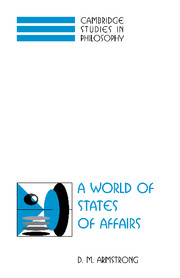Book contents
- Frontmatter
- Contents
- Preface
- 1 Introduction
- 2 Some preliminary doctrines
- 3 Properties I
- 4 Properties II
- 5 Powers and dispositions
- 6 Relations
- 7 Particulars
- 8 States of affairs
- 9 Independence
- 10 Modality
- 11 Number
- 12 Classes
- 13 Totality states of affairs
- 14 Singular causation
- 15 Laws I
- 16 Laws II
- 17 The unity of the world
- References
- Index
4 - Properties II
Published online by Cambridge University Press: 03 February 2010
- Frontmatter
- Contents
- Preface
- 1 Introduction
- 2 Some preliminary doctrines
- 3 Properties I
- 4 Properties II
- 5 Powers and dispositions
- 6 Relations
- 7 Particulars
- 8 States of affairs
- 9 Independence
- 10 Modality
- 11 Number
- 12 Classes
- 13 Totality states of affairs
- 14 Singular causation
- 15 Laws I
- 16 Laws II
- 17 The unity of the world
- References
- Index
Summary
RESEMBLANCES AMONG UNIVERSALS
Introductory
The topic of properties is not easily disposed of! We come now to consider one of the most difficult issues in the theory of universals. Not only do particulars resemble, but so do properties and relations. And just as particulars may resemble each other more or less closely, so the same is true of properties and relations. Thus: all the colours resemble each other, and a consideration of red, orange and yellow, and again red, purple and blue, shows that one colour can resemble a second colour more than it resembles a third.
Before getting on with our main topic, it is interesting and important to notice that these very same resemblance relations appear among the tropes. Suppose that the colours spoken of in the last sentence of the previous paragraph are not universals, but are particulars, tropes. Any red trope resembles any orange trope more than it resembles any yellow trope, and any red trope resembles any purple trope more than it resembles any blue trope. What we have is a further parallelism between universals and tropes. We will not, however, take the matter further here. (But see Armstrong, 1989a, ch. 6, sec. V especially.)
Resemblance orderings of universals are not subjective phenomena. This is obvious in the case of most of the great orderings of properties into classes.
- Type
- Chapter
- Information
- A World of States of Affairs , pp. 47 - 68Publisher: Cambridge University PressPrint publication year: 1997



